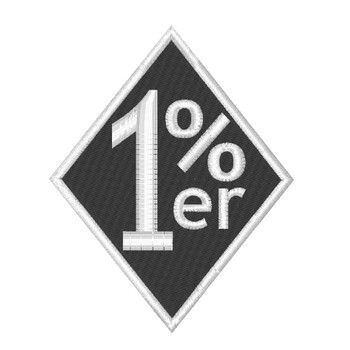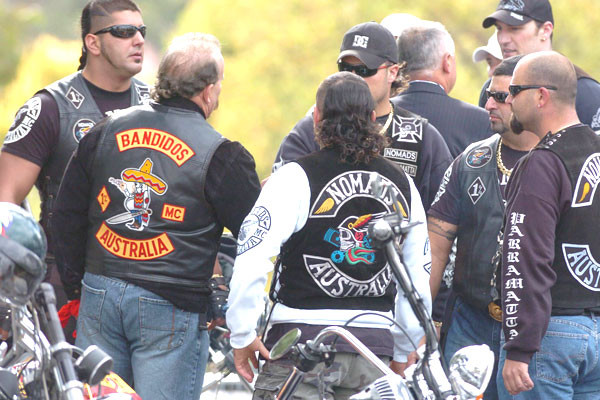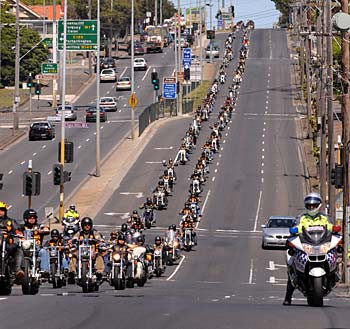The term “One Percenter Biker Gang,” often synonymous with “outlaw motorcycle club,” refers to motorcycle clubs that operate outside the norms and laws adhered to by the vast majority of motorcycle riders. This distinction sets them apart from the 99% of motorcyclists who are law-abiding citizens, a contrast highlighted by the very patch they proudly wear: the ‘1%’ patch. Clubs like the Hells Angels, Bandidos, Pagans, and Outlaws are prominent examples of these one percenter clubs, groups that have carved out a controversial yet undeniably significant place in motorcycle culture.
 one percenter patch
one percenter patch
alt: One Percenter Patch Symbol on Leather Vest, Representing Outlaw Motorcycle Gangs
The Origin of the One Percenter Term: Hollister and the AMA
The expression “one percenter” emerged from the aftermath of the 1947 Hollister Riot in California. This event, sensationalized in media, involved a large gathering of motorcyclists and subsequent public disturbances. In response, the American Motorcycle Association (AMA), aiming to distance the broader motorcycling community from such events, reportedly stated that 99% of motorcycle riders were law-abiding citizens. In a rebellious counter-move, certain motorcycle clubs at the time adopted the “one percenter” moniker, effectively declaring themselves to be the dissenting 1% – those who lived outside societal norms and AMA regulations. This self-identification became a badge of honor, signifying their outlaw status and rejection of mainstream motorcycle culture.
Post-War Origins of Outlaw Motorcycle Clubs
The rise of outlaw motorcycle clubs gained considerable traction in the latter part of the 1940s, a period directly following World War II. This timing was far from coincidental. The end of the war saw a large influx of veterans returning home, many of whom struggled to readjust to civilian life. For individuals who had experienced the intense camaraderie and adrenaline of combat, the normalcy of post-war society could feel mundane and unsatisfying.
Simultaneously, the market was flooded with surplus Harley Davidson motorcycles, previously used by the military. These bikes were readily available and affordable, providing an ideal outlet for ex-servicemen seeking to recapture the excitement and brotherhood they had experienced during the war. The combination of these factors – a yearning for excitement and camaraderie among veterans and the accessibility of powerful motorcycles – fueled the growth of outlaw motorcycle clubs. These clubs offered a sense of belonging, adventure, and a continuation of the brotherhood forged in the military, but now within a civilian context that often clashed with societal expectations.
 multiple one percenter clubs meeting
multiple one percenter clubs meeting
alt: Meeting of Multiple One Percenter Motorcycle Clubs, Featuring Members and Bikes
Prominent One Percenter Motorcycle Clubs Around the Globe
One percenter motorcycle clubs are not confined to any single geographical location; they have a global presence. Clubs like the Hells Angels Motorcycle Club and the Outlaws Motorcycle Club, recognized internationally, have expanded by forming local chapters in numerous cities and countries. These chapters, while operating under the umbrella of the larger club, maintain a degree of local autonomy. Despite their “outlaw” image, these motorcycle clubs often operate as legal entities and generate revenue through the sale of branded merchandise, known as “supporter gear,” to both members and the public.
Some of the most widely recognized one percenter motorcycle clubs include:
- Hells Angels Motorcycle Club (HAMC): Perhaps the most infamous and globally recognized one percenter club.
- Outlaws Motorcycle Club (AOA): A long-standing rival of the Hells Angels, also with a significant international presence.
- Bandidos Motorcycle Club: Another major international club, known for its strong presence in the Southern United States and Europe.
- Pagans Motorcycle Club: Primarily based in the Eastern United States, known for its particularly insular and secretive nature.
- Mongols Motorcycle Club: Started in California, and has grown to have a significant presence, often considered rivals to the Hells Angels.
The Significance of the 1% Patch
For clubs identifying as one percenter motorcycle clubs, the “1%” or “1%er” patch worn on their vests is a paramount symbol. It’s not merely a decoration; it’s a declaration of identity and allegiance. This patch signifies a member’s commitment to the outlaw biker lifestyle and their club, representing their separation from mainstream society and adherence to a different set of rules and values. Wearing the 1% patch is a bold statement of belonging to this counter-culture and a rejection of the perceived conformity of the “99%.”
Media Portrayal and Public Perception of One Percenters
Media coverage of one percenter motorcycle clubs frequently centers on stories of criminal activity, often highlighting instances of violence. While it’s undeniable that some members of these clubs have been involved in criminal acts, the extent and nature of media attention can often create a skewed and disproportionately negative public perception. Sensationalized reporting can amplify fear and contribute to a generalized view of all one percenter clubs as inherently violent and criminal organizations.
It’s important to acknowledge that while crimes do occur, much of the violence associated with outlaw motorcycle clubs is often internal, involving conflicts between rival clubs. The adage “stay out of their way, and they will stay out of yours” often reflects the reality for the general public. However, this is not to diminish the real harm that has been inflicted on innocent individuals in some instances.
 one percenter bikers and police
one percenter bikers and police
alt: One Percenter Bikers and Police Presence, Illustrating Law Enforcement Scrutiny
Government Scrutiny and the RICO Act
Law enforcement agencies and governments worldwide closely monitor one percenter motorcycle clubs. In the United States, federal agencies have utilized the Racketeer Influenced and Corrupt Organizations (RICO) Act against major clubs like the Hells Angels, Bandidos, Outlaws, and Pagans. The RICO statute, initially designed to combat organized crime syndicates like the Mafia, allows for the prosecution of entire organizations and their leadership for racketeering activities.
Beyond the US, governments in other countries are also implementing strategies to counter outlaw motorcycle gangs. These measures include enacting legislation aimed at disrupting club operations, such as laws prohibiting members from associating with one another. These governmental actions reflect the serious view taken towards one percenter clubs and the perceived threat they pose to public order and safety.
In conclusion, the term “one percenter biker gang” encapsulates a complex subculture rooted in post-war societal shifts, a rebellious spirit, and a rejection of mainstream norms. While media portrayals often focus on the criminal aspects, understanding the historical context, the sense of brotherhood, and the self-defined outlaw identity is crucial to grasping the phenomenon of one percenter motorcycle clubs.
